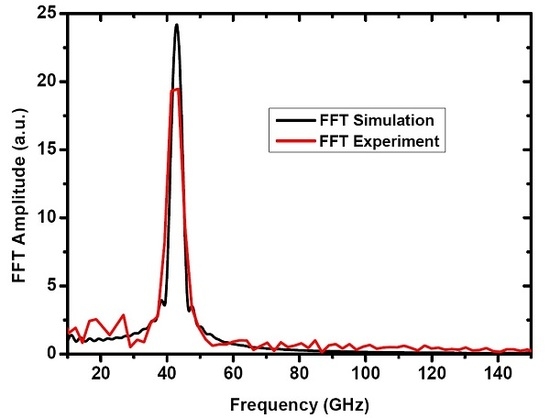A Basic Complete Numerical Toolbox for Picosecond Ultrasonics
Abstract
1. Presentation of the General Concept
2. Numerical Study
2.1. Optical Absorption Coefficient and Optical Depth Penetration
| //Scilab code (part 01/13) clear all //Clear clc() //Clear lambdap = 800.8 * 10^(-9) //Probe optical wavelength (m) lambdas = 800.8 * 10^(-9) //Pump optical wavelength (m) n0 = 1.0002772 //Air around the sample (refractive index)k0 = (2*%pi*n0)/lambdas //Evaluation of the wavevector for optical wave Z0 = 0.0429 * 10^(4) //Acoustic impedance of the air (kg.m-2.s-1) //Density of the medium (kg.m-3) rhoGaAs = 5317 //5.320 g.cm-3 (reference value) //Angle value close to zero (normal incidence for pump beam) //thetaDeg = 0 thetaDeg = 45 //for probe theta = thetaDeg * (%pi/180) //Angle (from degrees to radians) |
| //Scilab code (part 02/13) //GaAs bulk parameters (taken at 1.55 eV exact value) //Refraction index values at the wavelength (nm) for GaAs n2p = 3.66+%i*0.08 //1.55 eV (800.8 nm) n2s = 3.66+%i*0.08 //1.55 eV (800.8 nm) nGaAs=real(n2s) //Optical absorption coefficient (pump and probe) alphas=4*%pi*imag(n2s)/lambdas alphap=4*%pi*imag(n2p)/lambdas //Optical depth penetration for probe and pump xis=1/(alphas) xip=1/(alphap) //Ratio between optical depth penetration (test, should be equal to 1) ratioxi=xip/xis |
2.2. Acoustic Velocities Calculations
| //Scilab code (part 03/13) T = 298.15 //Temperature considered (K), room temperature (RT) condition //Stiffness matrix coefficient values //Units: dyn/cm2 divided by 10 \textcolor{black}{corresponds to} N/m2 c11= ((12.17-1.44*T*1e-3)/10)*1e11 //Elastic rigidity (N/m^2) c12= ((5.46 - 0.64*T*1e-3)/10)*1e11 //Elastic rigidity (N/m^2) c44= ((6.16 - 0.70*T*1e-3)/10)*1e11 //Elastic rigidity (N/m^2) |
| //Scilab code (part 04/13) //Anisotropy factor (adimensional factor) A=(2*c44)/(c11-c12) //Pure longitudinal wave [100] direction VLAGaAsEstim=(c11/rhoGaAs)^0.5 //Pure shear wave [010] polarized VTAGaAsEstim=(c44/rhoGaAs)^0.5 //Quasi-longitudinal wave VQLAGaAsEstim=((c11+(c44*(1-(1/A))))/rhoGaAs)^0.5 //Quasi-shear wave VQTAGaAsEstim= (c44/(A*rhoGaAs))^0.5 //Acoustic impedance for GaAs bulk material (kg.m-2.s-1) ZGaAs = rhoGaAs * VLAGaAsEstim //Evaluation of difference of impedance values (kg.m-2.s-1) \textcolor{black}{//Test} DeltaZ = ZGaAs-Z0 \textcolor{black} {//Z0 impedance of the air (reference level)} Diff=DeltaZ/ZGaAs*100 \textcolor{black} {//Strong or low interface)} |
2.3. Brillouin Frequencies Calculations
| //Scilab code (part 05/13) //Brillouin frequency mode value (Hz) for LA mode fBLA=((2*VLAGaAsEstim)/lambdas)*((nGaAs*nGaAs)-(sin(theta))^2)^(0.5) fBLA_GHz = fBLA * 10^(-9) //Brillouin frequency mode value (Hz) for TA mode fBTA=((2*VTAGaAsEstim)/lambdas)*((nGaAs*nGaAs)-(sin(theta))^2)^(0.5) fBTA_GHz = fBTA * 10^(-9) //Brillouin frequency mode value (Hz) for QLA mode fBQLA=((2*VQLAGaAsEstim)/lambdas)*((nGaAs*nGaAs)-(sin(theta))^2)^(0.5) fBQLA_GHz = fBQLA * 10^(-9) //Brillouin frequency mode value (Hz) for QTA mode fBQTA=((2*VQTAGaAsEstim)/lambdas)*((nGaAs*nGaAs)-(sin(theta))^2)^(0.5) fBQTA_GHz = fBQTA * 10^(-9) |
| //Scilab code (part 06/13) VLAGaAsEstim=(c11/rhoGaAs)^0.5 fBLA=((2*VLAGaAsEstim)/lambdas)*((nGaAs*nGaAs)-(sin(theta))^2)^(0.5) //Brillouin frequency mode value (Hz) for LA mode fBLA_GHz = fBLA * 1e-9 scf(0) clf(0) T=0:5:1400; plot(T,fBLA_GHz,’-o’); xlabel(’Temperature (K)’) ylabel(’Brillouin frequency (GHz)’) title(’Impact of the temperature onto the Brillouin frequency, for 45 angle incidence to normal direction.’) |
| //Scilab code (part 07/13) clear all //Clear clc() //Clear T = 298.15 //25 degrees, temperature of the medium //Elastic coefficient for GaAs (elastic rigidity expressed in N/m^2) c11= ((12.17-1.44*T*1e-3)/10)*1e11 c12= ((5.46 - 0.64*T*1e-3)/10)*1e11 c44= ((6.16 - 0.70*T*1e-3)/10)*1e11 A=(2*c44)/(c11-c12) rhoGaAs = 5317 thetaDeg=0:2:80; theta = thetaDeg * (%pi/180) VLAGaAsEstim=(c11/rhoGaAs)^0.5 fBLA=((2*VLAGaAsEstim)/lambdas)*((nGaAs*nGaAs)-(sin(theta))^2)^(0.5) fBLA_GHz = fBLA * 1e-9 scf(0) clf(0) thetaDeg=0:2:80; plot(thetaDeg,fBLA_GHz,’-o’); xlabel(’Incidence angle (degree)’) ylabel(’Brillouin frequency (GHz)’) title(’Impact of the angle incidence value onto the Brillouin frequency, for 298.15 K temperature.’) |
2.4. Deformation Field Simulation
2.5. Deformation Field
| //Scilab code (part 08/13) //Heaviside step function H(z) definition deff(’y=H(x)’,’if x<0 then y=0;else y=1;end;’) function[Sci]=defo(alphap,t,z) defs3= (2-exp(-alphap.*VLAGaAsEstim.*t))*exp(-alphap*z)*H(z)- H(z-VLAGaAsEstim*t)*exp(-alphap*abs(z-VLAGaAsEstim*t)); def=1.5*defs3; //Arbitrary scale factor Sci=def’; endfunction |
| //Scilab code (part 09/13) //Photo-induced deformation field (red pump beam) //Coefficient Ra20 Ra20=(-ZGaAs+Z0)/(ZGaAs+Z0) scf(0) clf(0) //Time between 0 ps and 100 ps, step of 1ps for t=0:5e-12:130e-12; //initial index p p=0; //Space variable from 0.5 nm to 800 nm (bulk), step of 1 nm for z=0e-9:2.5e-9:1800e-9; p=p+1; //Direct propagation of the wavefront into the bulk defs3(p)= (2-exp(-alphap.*VLAGaAsEstim.*t))*exp(-alphap*z)*H(z)- H((z)-VLAGaAsEstim*t)*exp(-alphap*abs((z)-VLAGaAsEstim*t)); //defor3(p)= H(z-VLAGaAsEstim*t)*exp(-alphap*abs(z-VLAGaAsEstim*t)); defs(p)=1*defs3(p); end z=0e-9:2.5e-9:1800e-9; plot(z,defs,’-.o’) xlabel(’In-depth direction (m)’) ylabel(’Deformation field (no unit)’) title(’Spatial evolution of the deformation field for in-depth coordinate. Interface air/GaAs at 0 nm’) end |
2.6. Transient Optical Reflectivity Simulation
| //Scilab code (part 10/13) p11=(8+%i*(3))*1e-9; //Coefficient at 800 nm p12=(-4+%i*(-3))*1e-9; //Coefficient at 800 nm pe=(p11*c11+2*p12*c12)/(2*n2s) //Photo-elastic coefficient (p11, p12, p44) of the photo-elastic tensor pe2=1*(2*%pi/lambdas)*(p11*c11+2*p12*c12)/(2*n2s) //to compare with (test): //Photo-elastic coefficient (p11, p12, p44) of the photo-elastic tensor pe2=1*(2*%pi/lambdas)*pe |
| //Scilab code (part 11/13) k2s=2*%pi*n2s/lambdas //n2s related to the probe into GaAs r02=(n2s-n0)/(n0+n2s) ///Reflexion coefficient //Acoustic interface air-GaAs (at normal incidence) //Factor F for deformation integration F=(1-r02*r02)/r02 //Coefficient Ra20 (impedance ZGaAs and Z0 for air) Ra20=(-ZGaAs+Z0)/(ZGaAs+Z0) |
| //Scilab code (part 12/13) //Transient reflectivity (integration of deformation field) intS=0; //defor1=0; //defor2=0; defor3=0; k=0; for t=0:1e-12:6000e-12; //from 0 to 6 ns (time domain) k=k+1; r=0; for z=0:1e-9:1800e-9; //from 0 to 1800 nm (space domain) r=r+1; defor3(r)=(defo(alphap,t,z).*exp(2*%i*k2s*z))’; end z=0:1e-9:1800e-9; //from 0 to 1800 nm (space domain for integration) intS(k)=0.5*pe2*(1/r02-r02).*inttrap(z,defor3); //Trapezoidal integration end t=0:1e-12:6000e-12; //from 0 to 6 ns (time domain) //Transient reflectivity variation (empiric exponential decay added) drr=real(intS’)+50*exp(-t/(20e-12)); scf(1) clf(1) plot2d(t,drr);//Simulation graphic representation |
| //Scilab code (part 13/13) sample_rate=1e12 t = 0e-12:1/sample_rate:6000e-12 N=size(t,’*’) //number of samples g=fft(drr,-1) f=sample_rate*(0:(N/2))/N;//associated frequency vector n=size(f,’*’) scf(2) //clear the figure clf(2) //Maximum values for frequencies [m,k]=max(f) answer=max(f) //maximum vertical axis (m) plot(f,abs(g(1:n))); |
3. Conclusions
Funding
Acknowledgments
Conflicts of Interest
References
- Thomsen, C.; Strait, J.; Vardeny, Z.; Maris, H.J.; Tauc, J.; Hauser, J. Coherent phonon generation and detection by picosecond light pulses. Phys. Rev. Lett. 1984, 53, 989. [Google Scholar] [CrossRef]
- Eesley, G.L.; Clemens, B.M.; Paddock, C.A. Generation and detection of picosecond acoustic pulses in thin metal films. Appl. Phys. Lett. 1987, 50, 717–719. [Google Scholar] [CrossRef]
- Ruello, P.; Gusev, V.E. Physical mechanisms of coherent acoustic phonons generation by ultrafast laser action. Ultrasonics 2015, 56, 21–35. [Google Scholar] [CrossRef]
- Gusev, V. Laser hypersonics in fundamental and applied research. Acustica 1996, 82, S-37–S-45. [Google Scholar]
- Kozhushko, V.V.; Hess, P. Laser-induced focused ultrasound for nondestructive testing and evaluation. J. Appl. Phys. 2008, 103, 124902. [Google Scholar] [CrossRef]
- Ivochkin, A.Y.; Karabutov, A.; Lyamshev, M.; Pelivanov, I.; Rohatgi, U.; Subudhi, M. Measurement of velocity distribution for longitudinal acoustic waves in welds by a laser optoacoustic technique. Acoust. Phys. 2007, 53, 471–477. [Google Scholar] [CrossRef]
- Thomsen, C.; Grahn, H.T.; Maris, H.J.; Tauc, J. Surface generation and detection of phonons by picosecond light pulses. Phys. Rev. B 1986, 34, 4129. [Google Scholar] [CrossRef]
- Babilotte, P.; Ruello, P.; Mounier, D.; Pezeril, T.; Vaudel, G.; Edely, M.; Breteau, J.; Gusev, V.; Blary, K. Femtosecond laser generation and detection of high-frequency acoustic phonons in GaAs semiconductors. Phys. Rev. B 2010, 81, 245207. [Google Scholar] [CrossRef]
- Devos, A.; Cote, R.; Caruyer, G.; Lefevre, A. A different way of performing picosecond ultrasonic measurements in thin transparent films based on laser-wavelength effects. Appl. Phys. Lett. 2005, 86, 211903. [Google Scholar] [CrossRef]
- Devos, A.; Lerouge, C. Evidence of laser-wavelength effect in picosecond ultrasonics: Possible connection with interband transitions. Phys. Rev. Lett. 2001, 86, 2669. [Google Scholar] [CrossRef]
- Perrin, B.; Bonello, B.; Jeannet, J.; Romatet, E. Interferometric detection of hypersound waves in modulated structures. Prog. Nat. Sci. 1996, 6, S444–S448. [Google Scholar]
- Wiesenfeld, J.M. Acoustic phonon generation in the picosecond dynamics of dense electron-hole plasmas in InGaAsP films. Appl. Phys. Lett. 1985, 47, 143–145. [Google Scholar] [CrossRef]
- Thomsen, C.; Grahn, H.; Maris, H.; Tauc, J. Picosecond interferometric technique for study of phonons in the Brillouin frequency range. Opt. Commun. 1986, 60, 55–58. [Google Scholar] [CrossRef]
- Gusev, V.E.; Karabutov, A.A. Laser Optoacoustics. In NASA STI/Recon Technical Report A; NASA: Washington, DC, USA, 1991; Volume 93. [Google Scholar]
- Grahn, H.T.; Maris, H.J.; Tauc, J. Picosecond ultrasonics. IEEE J. Quantum Electron. 1989, 25, 2562–2569. [Google Scholar] [CrossRef]
- Karabutov, A.; Larichev, V.; Maksimov, G.; Pelivanov, I.; Podymova, N. Relaxation dynamics of a broadband nanosecond acoustic pulse in a bubbly medium. Acoust. Phys. 2006, 52, 582–588. [Google Scholar] [CrossRef]
- Shelton, L.; Yang, F.; Ford, W.; Maris, H. Picosecond ultrasonic measurement of the velocity of phonons in water. Phys. Status Solidi B 2005, 242, 1379–1382. [Google Scholar] [CrossRef]
- Tas, G.; Stoner, R.; Maris, H.; Rubloff, G.; Oehrlein, G.; Halbout, J. Noninvasive picosecond ultrasonic detection of ultrathin interfacial layers: CF x at the Al/Si interface. Appl. Phys. Lett. 1992, 61, 1787–1789. [Google Scholar] [CrossRef]
- Lomonosov, A.; Mayer, A.P.; Hess, P. 3. Laser-based surface acoustic waves in materials science. Exp. Methods Phys. Sci. 2001, 39, 65–134. [Google Scholar]
- Bennis, A.; Lomonosov, A.; Shen, Z.; Hess, P. Laser-based measurement of elastic and mechanical properties of layered polycrystalline silicon structures with projection masks. Appl. Phys. Lett. 2006, 88, 101915. [Google Scholar] [CrossRef]
- Lehmann, G.; Lomonosov, A.; Hess, P.; Gumbsch, P. Impulsive fracture of fused quartz and silicon crystals by nonlinear surface acoustic waves. J. Appl. Phys. 2003, 94, 2907–2914. [Google Scholar] [CrossRef]
- Kozhushko, V.V.; Hess, P. Anisotropy of the strength of Si studied by a laser-based contact-free method. Phys. Rev. B 2007, 76, 144105. [Google Scholar] [CrossRef]
- Dubois, M.; Drake, T.E., Jr. Evolution of industrial laser-ultrasonic systems for the inspection of composites. Nondestruct. Test. Eval. 2011, 26, 213–228. [Google Scholar] [CrossRef]
- Dubois, M.; Burr, K.C.; Drake, T.E. Laser phase noise reduction for industrial interferometric applications. Appl. Opt. 2004, 43, 4399–4407. [Google Scholar] [CrossRef] [PubMed]
- Karabutov, A.; Devichensky, A.; Ivochkin, A.; Lyamshev, M.; Pelivanov, I.; Rohadgi, U.; Solomatin, V.; Subudhi, M. Laser ultrasonic diagnostics of residual stress. Ultrasonics 2008, 48, 631–635. [Google Scholar] [CrossRef] [PubMed]
- Xu, M.; Wang, L.V. Photoacoustic imaging in biomedicine. Rev. Sci. Instrum. 2006, 77, 041101. [Google Scholar] [CrossRef]
- Miklós, A.; Pei, S.C.; Kung, A. Multipass acoustically open photoacoustic detector for trace gas measurements. Appl. Opt. 2006, 45, 2529–2534. [Google Scholar] [CrossRef]
- Miklós, A.; Hess, P.; Bozóki, Z. Application of acoustic resonators in photoacoustic trace gas analysis and metrology. Rev. Sci. Instrum. 2001, 72, 1937–1955. [Google Scholar] [CrossRef]
- Bonello, B.; Armand, F.; Pradeau, J.; Perez, H.; Perrin, B.; Louis, G. Evidence for the alteration of an organic/metal interface resulting from the formation of a broad interfacial layer. J. Appl. Phys. 1999, 86, 4959–4963. [Google Scholar] [CrossRef]
- Moura, A.; Lomonosov, A.M.; Hess, P. Depth evaluation of surface-breaking cracks using laser-generated transmitted Rayleigh waves. J. Appl. Phys. 2008, 103, 084911. [Google Scholar] [CrossRef]
- Jian, X.; Dixon, S.; Guo, N.; Edwards, R. Rayleigh wave interaction with surface-breaking cracks. J. Appl. Phys. 2007, 101, 064906. [Google Scholar] [CrossRef]
- Kim, H.; Jhang, K.; Shin, M.; Kim, J. A noncontact NDE method using a laser generated focused-Lamb wave with enhanced defect-detection ability and spatial resolution. Ndt E Int. 2006, 39, 312–319. [Google Scholar] [CrossRef]
- Weiss, E.C.; Lemor, R.M.; Pilarczyk, G.; Anastasiadis, P.; Zinin, P.V. Imaging of focal contacts of chicken heart muscle cells by high-frequency acoustic microscopy. Ultrasound Med. Biol. 2007, 33, 1320–1326. [Google Scholar] [CrossRef] [PubMed]
- Monchalin, J.P. Laser-Ultrasonics: From the Laboratory to Industry. AIP Conf. Proc. 2004, 700, 3–31. [Google Scholar]
- Delale, C. Bubble Dynamics and Shock Waves; Springer: Berlin/Heidelberg, Germany, 2012. [Google Scholar]
- Castro, A.P.; Alves, H.W.L. Kinetic Monte Carlo simulation of the nitridation of the GaAs (100) surfaces. Braz. J. Phys. 2006, 36, 305–308. [Google Scholar] [CrossRef]
- Biegelsen, D.K.; Bringans, R.D.; Northrup, J.E.; Swartz, L.E. Surface reconstructions of GaAs(100) observed by scanning tunneling microscopy. Phys. Rev. B 1990, 41, 5701–5706. [Google Scholar] [CrossRef]
- Lu, Z.H.; Lagarde, C.; Sacher, E.; Currie, J.F.; Yelon, A. A surface analytical study of GaAs(100) cleaning procedures. J. Vacuum Sci. Technol. A 1989, 7, 646–650. [Google Scholar] [CrossRef]
- Blakemore, J.S. Semiconducting and other major properties of gallium arsenide. J. Appl. Phys. 1982, 53, R123–R181. [Google Scholar] [CrossRef]
- Wright, O.; Perrin, B.; Matsuda, O.; Gusev, V. Ultrafast carrier diffusion in gallium arsenide probed with picosecond acoustic pulses. Phys. Rev. B 2001, 64, 081202. [Google Scholar] [CrossRef]
- Devos, A.; Robillard, J.F.; Côte, R.; Emery, P. High-laser-wavelength sensitivity of the picosecond ultrasonic response in transparent thin films. Phys. Rev. B 2006, 74, 064114. [Google Scholar] [CrossRef]
- Burenkov, Y.A.; Burdukov, Y.M.; Davydov, S.Y.; SP, N. Temperature-dependence of gallium-arsenide elastic-constants. Fiz. Tverd. Tela 1973, 15, 1757–1761. [Google Scholar]
- Cote, R.; Devos, A. Refractive index, sound velocity and thickness of thin transparent films from multiple angles picosecond ultrasonics. Rev. Sci. Instrum. 2005, 76, 053906. [Google Scholar] [CrossRef]
- Mechri, C.; Ruello, P.; Gusev, V. Confined coherent acoustic modes in a tubular nanoporous alumina film probed by picosecond acoustics methods. New J. Phys. 2012, 14, 023048. [Google Scholar] [CrossRef]
- Wright, O. Thickness and sound velocity measurement in thin transparent films with laser picosecond acoustics. J. Appl. Phys. 1992, 71, 1617–1629. [Google Scholar] [CrossRef]
- Akhmanov, S.A.; Gusev, V.É. Laser excitation of ultrashort acoustic pulses: New possibilities in solid-state spectroscopy, diagnostics of fast processes, and nonlinear acoustics. Physics-Uspekhi 1992, 35, 153–191. [Google Scholar] [CrossRef]
- Devos, A.; Le Louarn, A. Strong effect of interband transitions in the picosecond ultrasonics response of metallic thin films. Phys. Rev. B 2003, 68, 045405. [Google Scholar] [CrossRef]
- Devos, A.; Côte, R. Strong oscillations detected by picosecond ultrasonics in silicon: Evidence for an electronic-structure effect. Phys. Rev. B 2004, 70, 125208. [Google Scholar] [CrossRef]
- Rothenberg, J.E. Observation of the transient expansion of heated surfaces by picosecond photothermal deflection spectroscopy. Opt. Lett. 1988, 13, 713–715. [Google Scholar] [CrossRef] [PubMed]
- Wright, O.; Gusev, V. Acoustic generation in crystalline silicon with femtosecond optical pulses. Appl. Phys. Lett. 1995, 66, 1190–1192. [Google Scholar] [CrossRef]
- Wright, O.B.; Gusev, V.E. Ultrafast generation of acoustic waves in copper. IEEE Trans. Ultrason. Ferroelectr. Freq. Control 1995, 42, 331–338. [Google Scholar] [CrossRef]
- Wright, O.B.; Hyoguchi, T.; Kawashima, K. Laser picosecond acoustics in thin films: Effect of elastic boundary conditions on pulse generation. Japan. J. Appl. Phys. 1991, 30, L131. [Google Scholar] [CrossRef]
- Wright, O.B.; Kawashima, K. Coherent phonon detection from ultrafast surface vibrations. Phys. Rev. Lett. 1992, 69, 1668. [Google Scholar] [CrossRef] [PubMed]
- Wright, O.; Gusev, V. Ultrafast acoustic phonon generation in gold. Physica B 1996, 219, 770–772. [Google Scholar] [CrossRef]
- Nelson, D.; Lax, M. New symmetry for acousto-optic scattering. Phys. Rev. Lett. 1970, 24, 379. [Google Scholar] [CrossRef]
- Etchegoin, P.; Kircher, J.; Cardona, M.; Grein, C.; Bustarret, E. Piezo-optics of GaAs. Phys. Rev. B 1992, 46, 15139. [Google Scholar] [CrossRef]
- Lin, H.; Maris, H.J.; Freund, L.B.; Lee, K.Y.; Luhn, H.; Kern, D.P. Study of vibrational modes of gold nanostructures by picosecond ultrasonics. J. Appl. Phys. 1993, 73, 37–45. [Google Scholar] [CrossRef]
- Chen, W.; Maris, H.J.; Wasilewski, Z.R.; Tamura, S.I. Attenuation and velocity of 56 GHz longitudinal phonons in gallium arsenide from 50 to 300 K. Philos. Mag. B 1994, 70, 687–698. [Google Scholar] [CrossRef]
- Jerri, A.J. The Shannon sampling theorem—Its various extensions and applications: A tutorial review. Proc. IEEE 1977, 65, 1565–1596. [Google Scholar] [CrossRef]
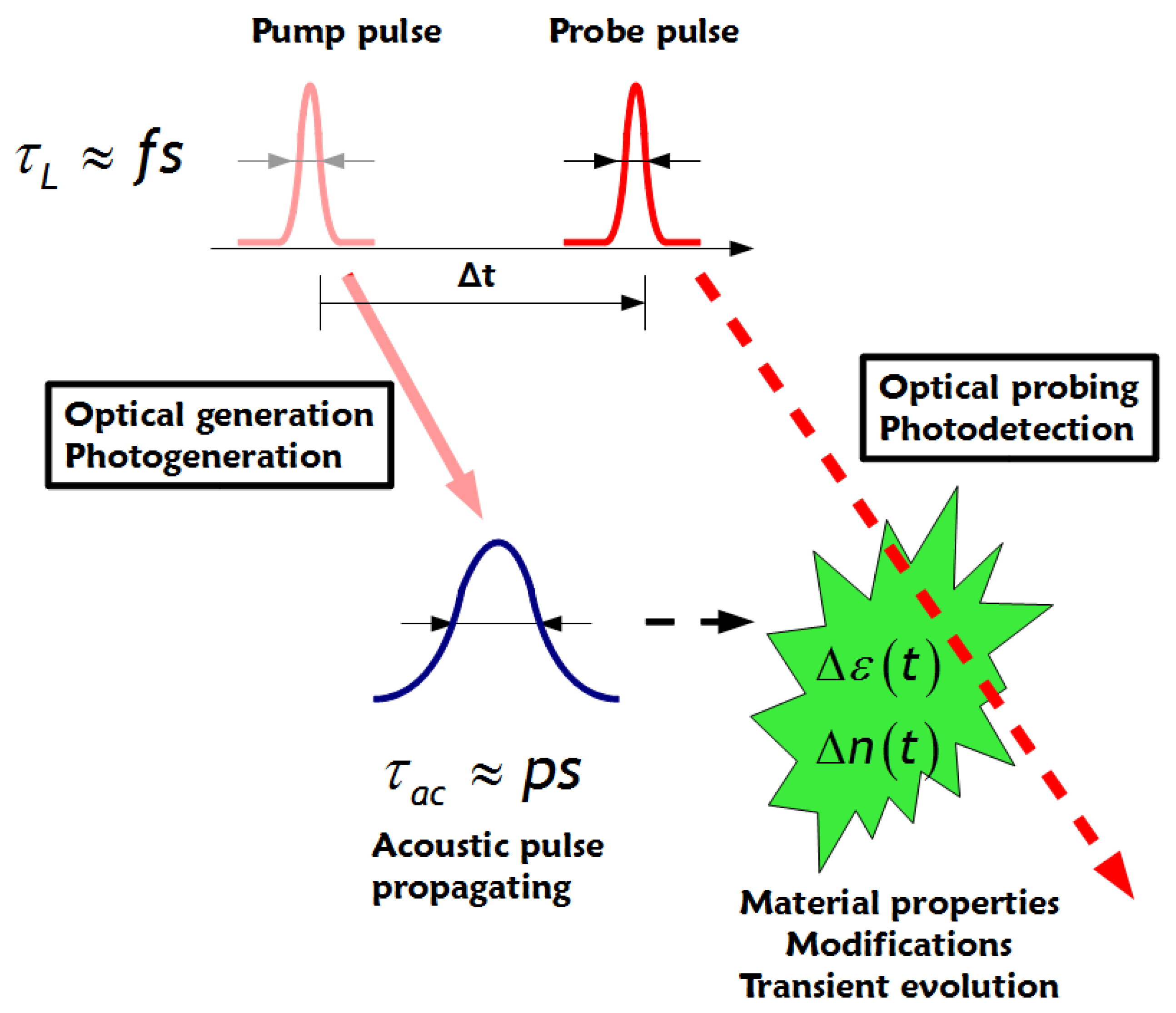
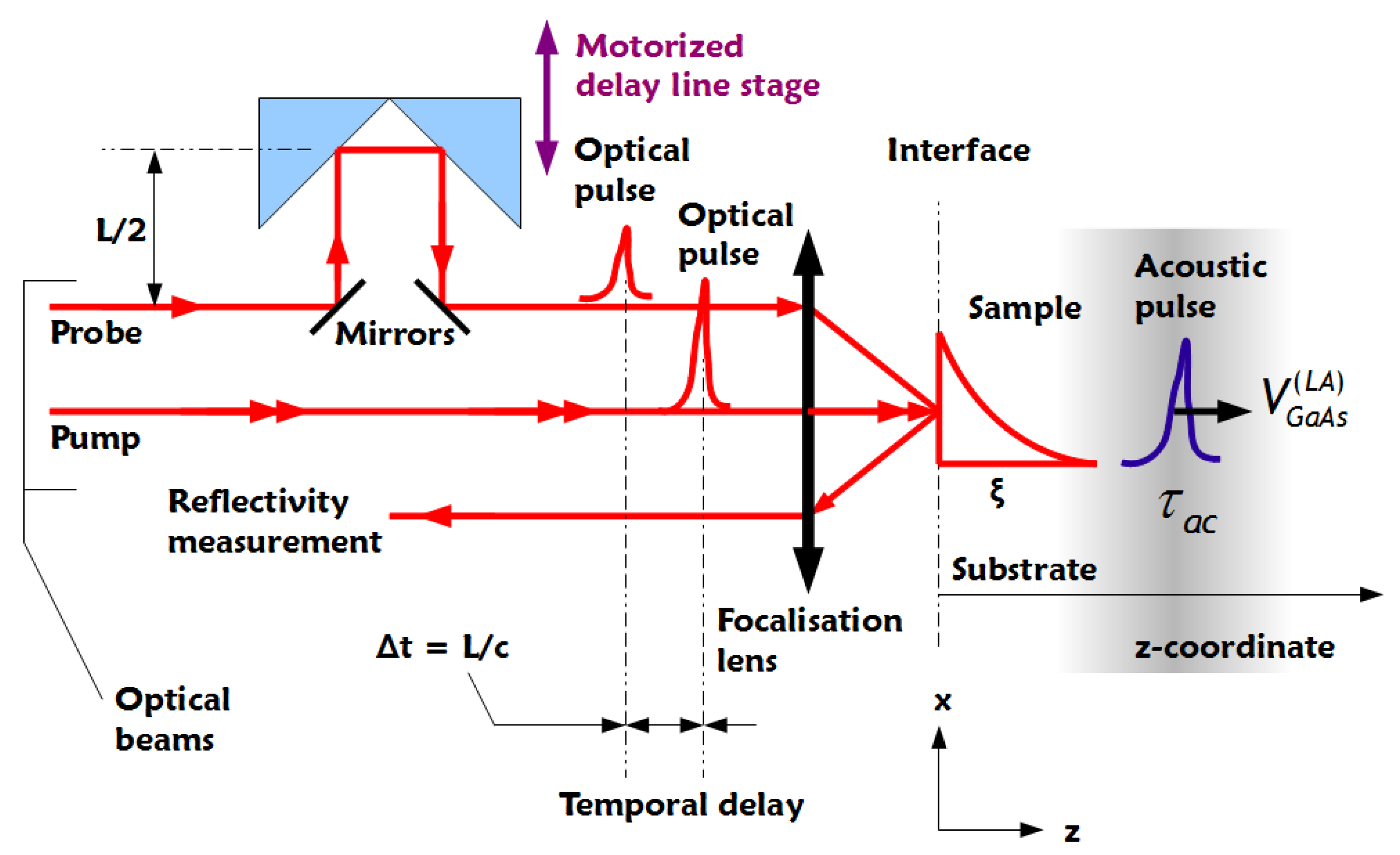

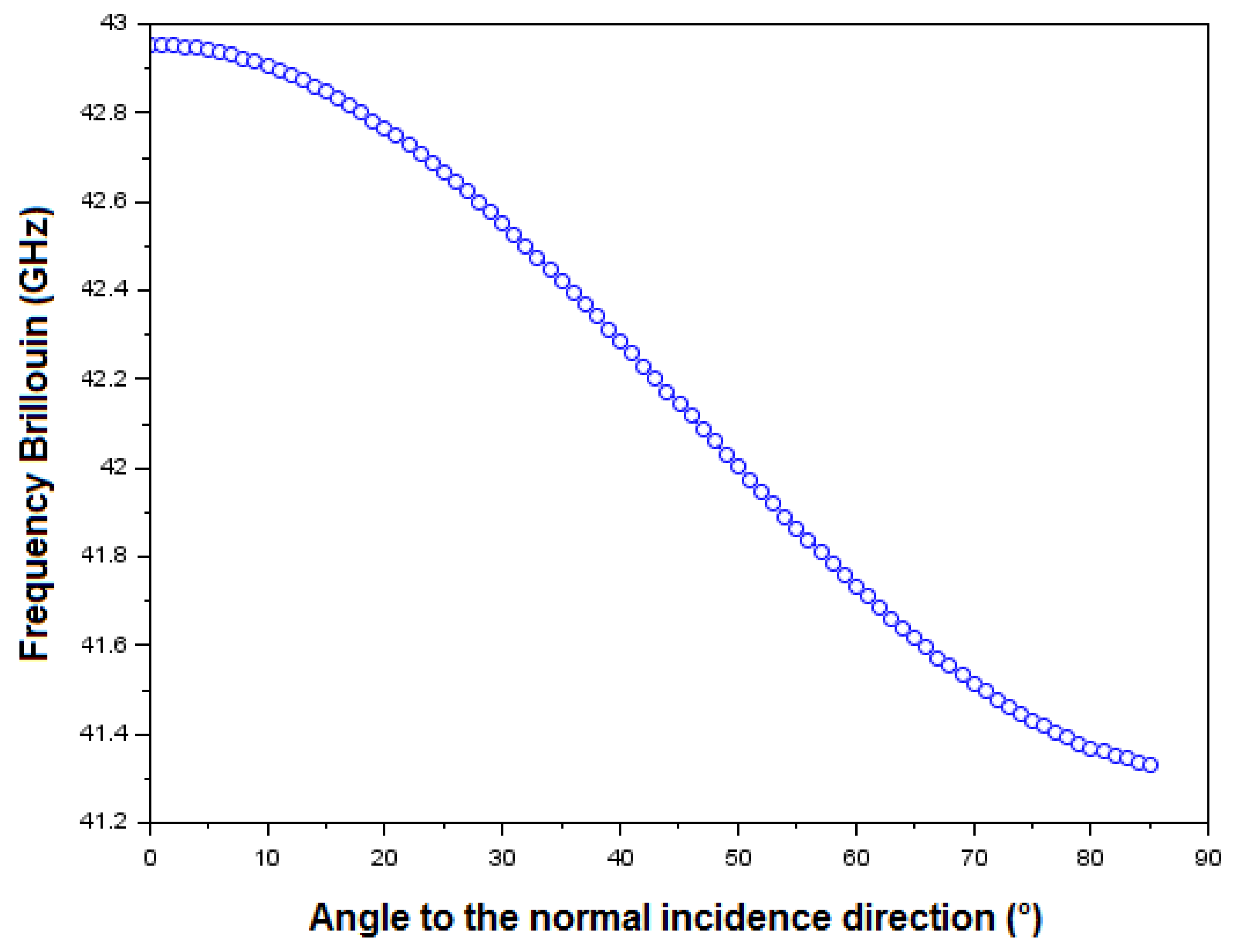
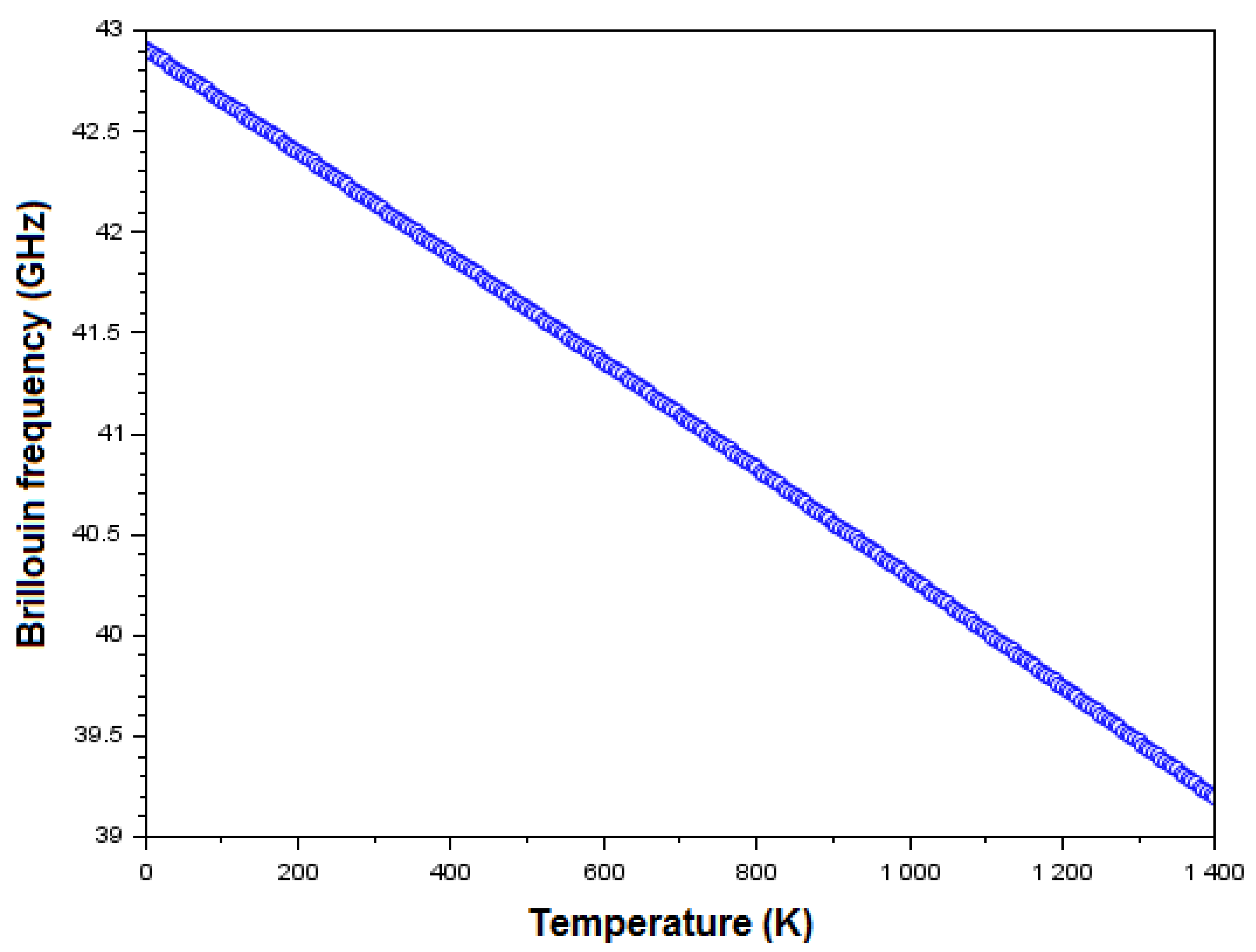
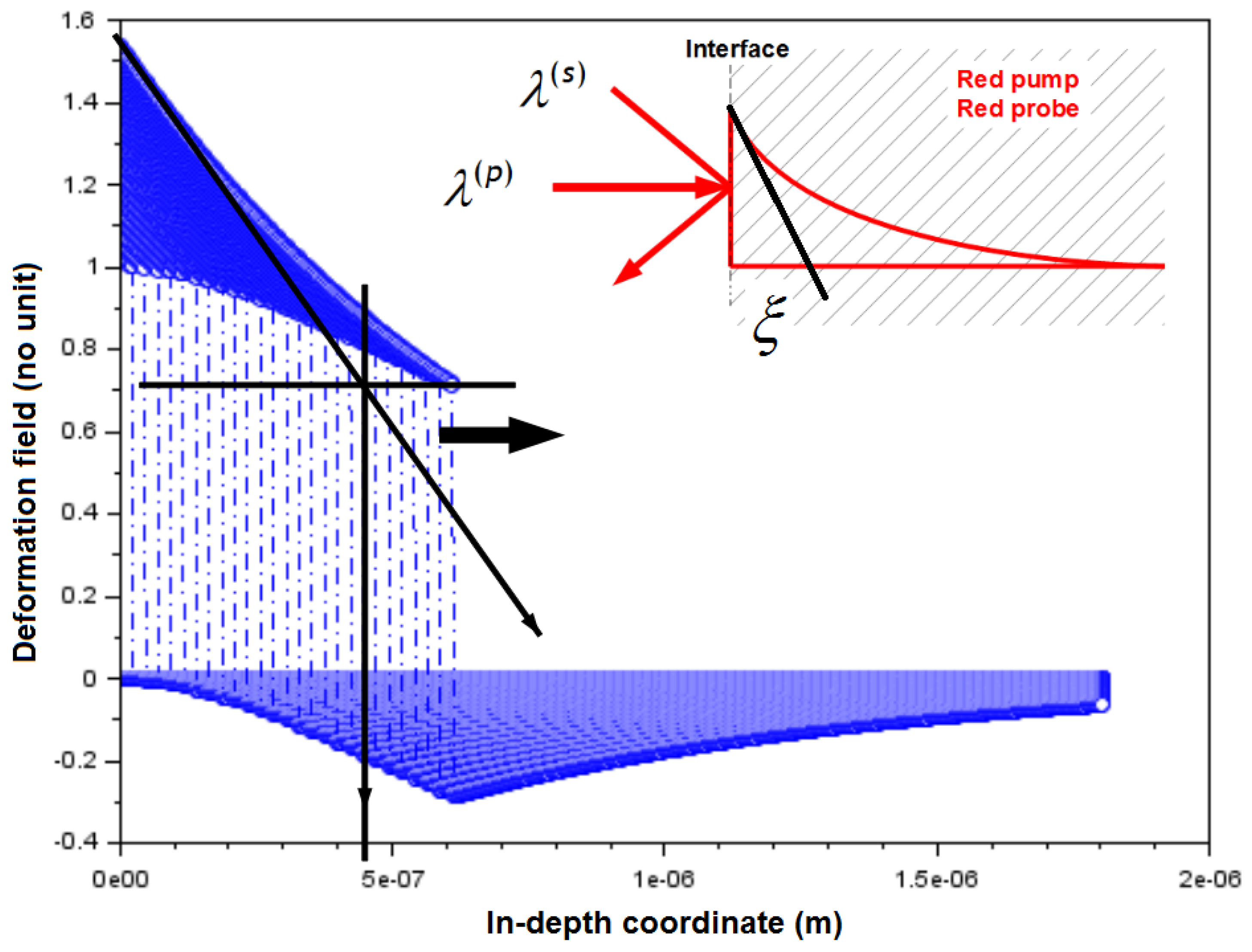
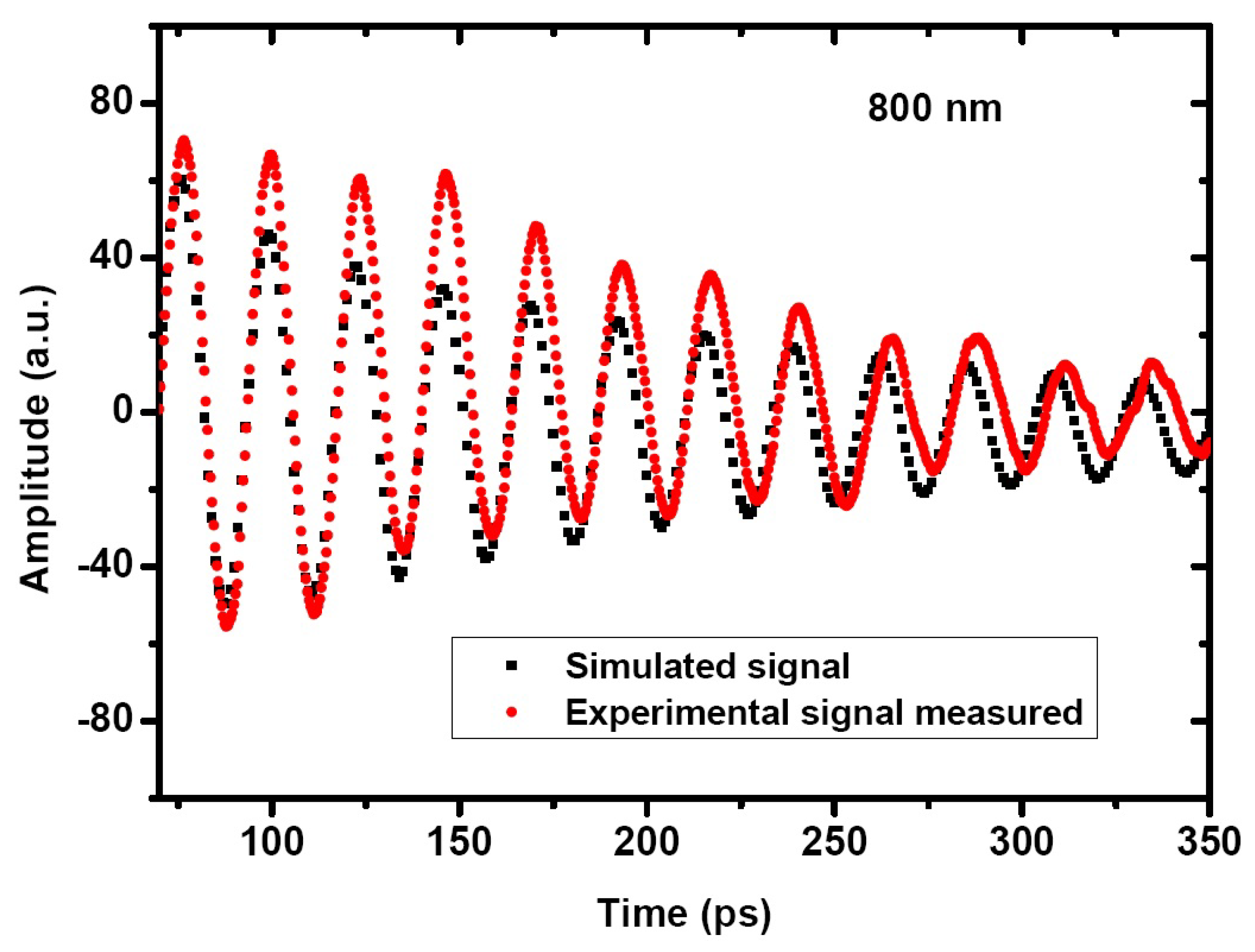
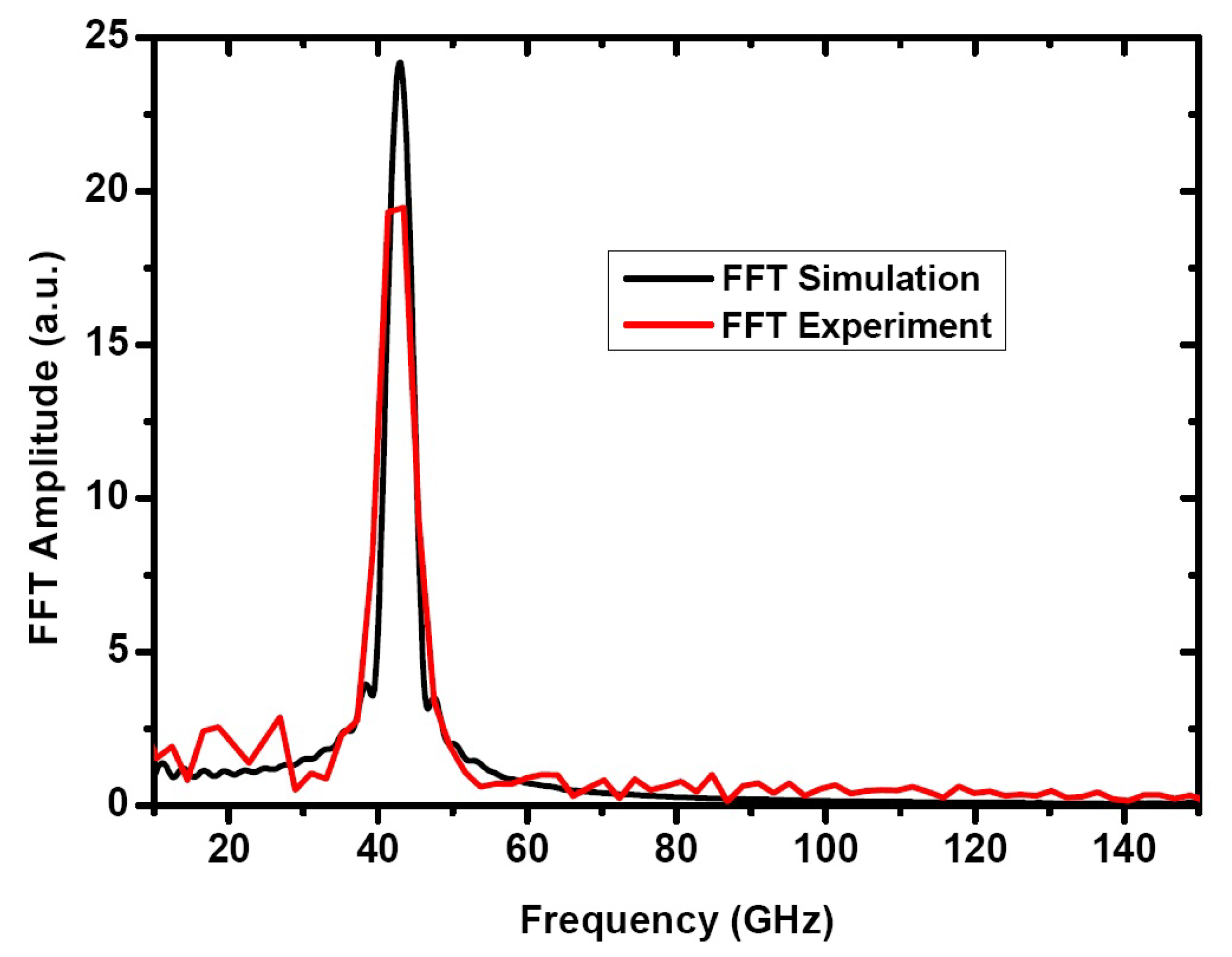
| Velocity | (m·s) | Brillouin Frequency | (GHz) |
|---|---|---|---|
© 2019 by the author. Licensee MDPI, Basel, Switzerland. This article is an open access article distributed under the terms and conditions of the Creative Commons Attribution (CC BY) license (http://creativecommons.org/licenses/by/4.0/).
Share and Cite
Babilotte, P. A Basic Complete Numerical Toolbox for Picosecond Ultrasonics. Acoustics 2019, 1, 137-155. https://doi.org/10.3390/acoustics1010010
Babilotte P. A Basic Complete Numerical Toolbox for Picosecond Ultrasonics. Acoustics. 2019; 1(1):137-155. https://doi.org/10.3390/acoustics1010010
Chicago/Turabian StyleBabilotte, Philippe. 2019. "A Basic Complete Numerical Toolbox for Picosecond Ultrasonics" Acoustics 1, no. 1: 137-155. https://doi.org/10.3390/acoustics1010010
APA StyleBabilotte, P. (2019). A Basic Complete Numerical Toolbox for Picosecond Ultrasonics. Acoustics, 1(1), 137-155. https://doi.org/10.3390/acoustics1010010



